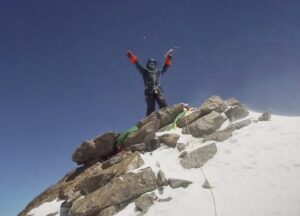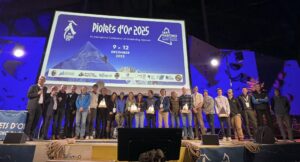The Amne Machin is the eastern extension of the Kunlun Mountains in Xinjiang, China. In the late 1980s, John Town described the range, also written as Anyemaqen, for the American Alpine Journal: “It lies at the northeastern extremity of the Tibetan Plateau, in a bend of the Yellow River, less than 300km from China. Finally and perhaps the most importantly, it is the home of the Goloks.”
Once the most feared tribe in Tibet, the Goloks’ territory spans roughly 76,000 sq km in southeastern Qinghai province. A warrior people, the Goloks are descendants of Tibetan warriors who protected the northern border of Tibet.

Above: A panoramic photo of Amne Machin and its different peaks. Below: Amne Machin I and II in 2010. Photos: Eduardo Martinez de Pison and Sebastian Alvaro
A sacred region
Amne Machin is revered by Tibetan Buddhists. It is considered the home of the Machen Pomra deity.
Machen Pomra (or Anye Maqen) is the fourth son of Wode, the protector god who lives on the mountain with 360 more divine entities. Wode sent Machen Pomra to the region to protect the Tibetan people from natural disasters. Machen Pomra fought demons, destroyed bad spirits, and subdued beasts. Thanks to his intervention, local people lived in peace and harmony.
This mountain range is holy, and until the intervention of the Chinese Communist Party in the 1960s, thousands of pilgrims made a circuit of the range every year. Then the Communist Party closed the region to foreigners for more than 20 years. It only reopened to climbers in 1980.

Eastern Kunlun. Photo: Sebastian Alvaro
The range and its peaks
“Amne Machin is not an ordinary mountain range,” Spanish geographer Eduardo Martinez de Pison wrote in his book Mas alla del Everest (Beyond Everest). “It is little known, little narrated, little described, without detailed maps. It’s a group of magical peaks, with their gods, celestial stories, rites, temples, beliefs, and mysterious meanings.”
The Amne Machin mountain range stretches more than 100km and includes several peaks higher than 5,000m. The lowest of these is Amne Machin IX at 5,690m. Three others are between 5,966m and 5,990m (Amne Machin VI, VII, and VIII) and five are higher than 6,000m. The highest, Amne Machin I, reaches 6,282m.

Amne Machin I (6,282m). Photo: Plus Chunichi
Confusion
Amne Machin I’s height was a matter of some confusion.
General George Pereira saw the mountain from 160km and believed that Amne Machin might be higher than Everest. He passed this information on to explorer Joseph Rock. Four years later, Rock tried to approach the mountain from the Yellow River but was threatened by the chief of the Goloks and stopped 80km short.
“I concluded that the Amne Machin towers were more than 28,000ft (8,500m),” Rock wrote in National Geographic.
In reality, Rock stated that the mountain was higher than 9,100m, but the editors decided to be more cautious. They published that it was “8,534m, or almost as high as Mount Everest.”
In 1956, Rock changed his tune, stating that Amne Machin was not much higher than 6,400m.

The summit of Amne Machin II, 6,268m. Photo: Ramon Portilla
The theory that the peak might be higher than 8,500m hung around for 20 years. In 1944, an American pilot reportedly sighted a peak higher than Everest. The news ran in international media worldwide. A Spanish newspaper even reported that a pilot flying over China had discovered a mountain higher than 10,000m!
However, climber Terris Moore, who had ascended Minya Konka in 1932 and had mapped the area, told The New York Times that he doubted the veracity of the news. Yet until the arrival of the first climbers, its true height remained a mystery.

A map of Amne Machin. In red circles: Amne Machin I and Amne Machin II. Photo: Eduardo Martinez de Pison
The 1960 Chinese climb
On June 6, 1960, climbers Pai Chin-Hsiao, Liu Chao-Chang, Wang Hung-Pao, Wang Wen-Chang, Hu Hui-Chih, Ai Shun-Feng, Chou Pin-Wei, and Ting Yuan-Tsung believed they had made the first ascent of Amne Machin I. They stated that the main peak was 7,160m. After this ascent, the Communist Party closed the area to climbing until the 1980s.
The first foreign climber to see the peak close-up was Mike Banks in 1980. Banks confirmed that the main peak was 6,282m. It became clear that the 1960 Chinese team had ascended Amne Machin II and not Amne Machin I.
In 1981, the Chinese government granted climbing permits for three teams from three countries. American climber Galen Rowell wrote that his team was unaware that other teams were allowed to climb the mountain during that summer.

A scene near Amne Machin. Photo: Sebastian Alvaro
The first ascent
The first ascent of Amne Machin I’s main peak was a Japanese team led by Yuzo Tada. The team consisted of 11 men and two women. On May 22, 1981, Yoshio Yamamoto, Giichiro Watanabe, and Katsumi Miyake reached the summit from the south along the long main ridge. Three days later, five more members of the team topped out.

Japanese climbers ascend Amne Machin. Photo: Japanese Magazine Archive
The second party to arrive at base camp was an Austrian-German group led by Siegfried Hupfauer. They wanted to do the Japanese route starting on June 2 but had to wait because of bad weather.
In the meantime, an American party also arrived. Kim Schmitz, Galen Rowell, and Harold Knutsen decided on a more direct route, via the east ridge of the northeast summit (6,154m) in alpine style. They summited Amne Machin I on June 9, 1981. On the summit, their altimeter showed 6,309m and they did not find any evidence of the previous Japanese team.
One day later, on June 10, 1981, the Austrian-German team of Hans Gaschbauer, Franz Lammerhofer, Gerhard Schmitz, Peter Vogler, and Siegfried Hupfauer topped out on the main peak too. After ascending the same route as the Japanese, the Germans stated that they found rope used by the Japanese and confirmed that they had indeed summited the mountain.
The same summer, Schmitz summited the peak again, with two clients. Then, another Japanese team led by Yakoto Torokawa reached the main summit that same summer.
Amne Machin I has a few more ascents but remains a remote mountain that still offers a lot of possibilities for climbers.






